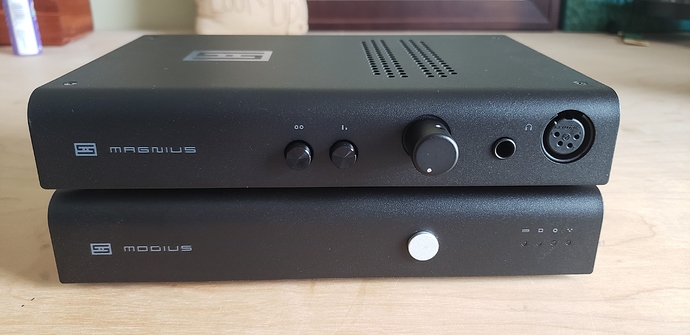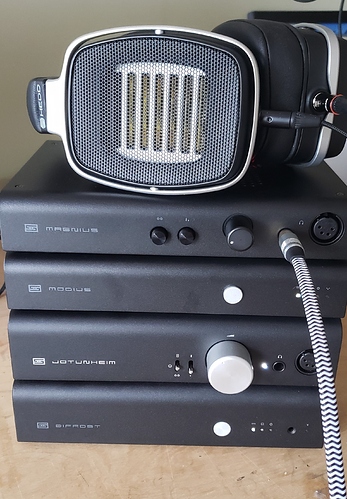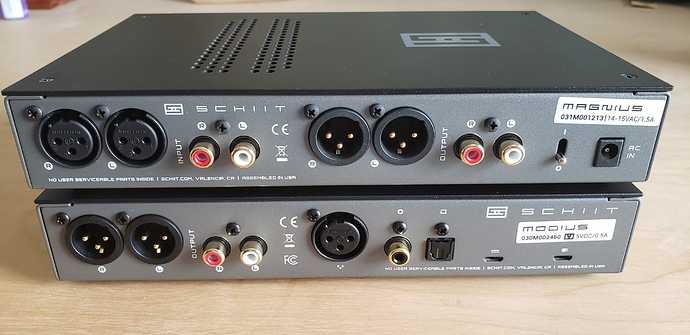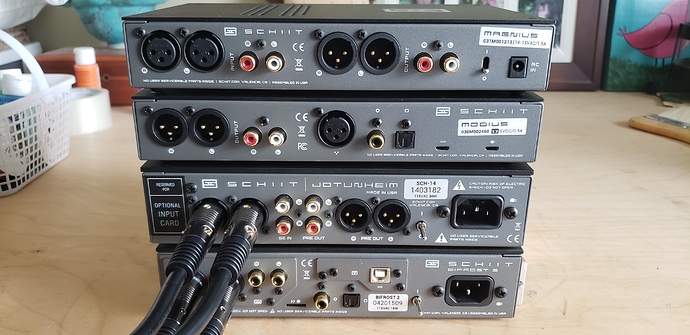Josh Valor Magnius Review:
i mean he is basically right because its just a magni heresy with a balanced output…
but im still buying the cheaper 3+ because it works well with a schiit stack
Was considering pairing this with my Modius/Asgard 3. But I’m not so sure anymore considering mixed early opinions.
I like that it has a neutral sound. This would complement the colored sound of the Asgard 3. That way switching from a SE cable to a balanced cable would have more purpose. Though, it doesn’t seem to match up to the performance of the Asgard 3.
Ok here is my experience with the Schiit Modius and Magnius…I was surprised.
Hello, after having the package from Schiit via Fedex becoming lost for a few days the new Schitt Modius and Magnius have arrived a few days late but intact, no damage and looking very nice.
After a few hints of an upcoming amp to match Modius I had to try this stack out and see what Schiit magic was cooking at the Schittr “plant”. My main gear I use daily are the Schiit Bifrost 2 (after years with Bifrost 1) and a Schiit Lyr 3 and Schiit Jotenheim. I also have many other amps in house about half retail and half DIY experiments.
The Modius and Magnius are a great looking pair. Black, stark looking IMO…some have complained that they would like silver here…understand and Schiits comments were “nope, in keeping costs down this was their decision”…doesnt affect the sound at all…One thing I do miss is some indication of it being on…no more front panel led etc…if its in a stack with something on it…its hard to tell if its on or not. There is a nice red led on the pcb that you can see thru the vents on the top…but if you put your Lyr 3 on top of it…
The Magnius is a wonderful amp. It shines. Whether is was being used in low or high gain it provided more than enough power to make the headphones I used play to very, very high levels. The volume knob is great, long enough to grasp nicely, firm, velvety smooth…and finally Schiit got this right!! They have a nice “visable” dot on the volume knob!! It appears to me a machine milled or drilled “dot” into the aluminum volume knob…ah its the small things!! Schiit has made a “big” thing about the pot in the Magnius, well its a really good Alps RK 27114 27mm Blue Velvet balanced potentiometer! Smooth and I had no low level tracking issues. Well done Schiit. Technology…sure…fully differential op-amps, current feedback, THD down to very, very low levels, and its Schiits best measuring amp if your into measurements. Its powered by the usual Schiit wall wort. But how does it sound or “not” sound…after all shouldnt an amp be a straight wire with gain and nothing more or less??
A great amp is only as good as its inputs? In this case it became very clear that the Magnius is a great amp. With inputs from Modius and Bifrost 2 the differences were stark IMO…very noticeable.
Which leads to the Modius connection.
Which can be had in either silver or black! It has the AKM 4493 d/a convertor and has both SE and fully balanced outputs to feed the Magnius or any other amp. DC coupled output…to some this is important. Very versatile with optical, coax, usb (Unison) and even AES sources. It pairs nicely with the Magnius physically. The analog stage is based on LME 49724 for the balanced outputs, an OPA 1662 for the SE outputs. Both are independent. So you can use the SE outs to a Lyr 3 and balanced to a Magnius or Jotenheim…nice. Unlike the Magnius power can come from a simple USB cable if your using Modius only as a dac. If you use the other digital inputs and NOT using USB then you need to use the included USB wall wart. The cosmetics of the Modius are simple elegance. A single push button to rotate thru the various inputs. Again no visable front panel led to indicate its powered up. The nice thing using the Unison UBS interface is it comes on when you turn on your PC. Simple. Nice.
Going back and forth with SE and balanced (both from the Bifrost 2) there is no audible difference in the overall sound quality and what I was hearing. The only thing that changes is the volume level in your headphones. Some reviews state the SE part of the Magnius measures not as well as the balanced section…for me this is not an issue and your not going to have any real sonic degradation at all. When I compared the Magnius I compared it with the Schiit Lyr 3 and Jotenheim and it compares nicely…not going to try to explain with glittering generalities the “minute” differences. When level matched and doing fair AB testing its difficult to state in objective terms the differences, subjectively they are there. But realistically this amp provides more than enough power, is clean, open and transparent under varying loads. For me to keep an amp it has to perform and make my listening experience “really good” and this amp does that very well. HIGHLY RECOMMENDED.
Now for the surprising “to me” part:
Headphones that I used in this “experience” were Focal Clears, relatively easy “load” for most amps and the newer HEDD headphones a bit less efficient to drive. I listened via the Magnius with first the Modius for several sessions and then Bifrost 2. It was an immediate difference for me with both headphones.
One was more clear, less veiled and less closed in than the other…being a critical listener, I checked and rechecked cabling and tried several sets of xlr interconnects as well. I was not expecting the difference to be this well “different”. I abandoned DS dacs years ago, so my Multibit dac ears are attuned to that r2r sound, especially from Schiits Bifrost 2. Modius has 4.0V RMS balanced and 2.0V single ended, and as does the Bifrost 2. So the Magnius was being driven with pretty much with the same voltages.
What I was hearing IMO was the difference between a “ds dac and a MB dac”. Schitts implementaion of the AKM chip is a very good one. Some reviews have stated that the S/N ratio exceeds the actual chip spec sheet…some reference to Schiit has some secret sauce here. I did not come to the following conclusions after reading other peoples reviews or experiences…and mine do differ.
So what did I experience…with my demo list of tunes, ripped 44.1/16 bit stuff playing with Foobar 2000 and Jriver MC 24…I went back and forth between the Modius and Bifrost 2. In all cases the Bifrost 2 was cleaner, crisper, more open, more transparent, less veiled in sound. Amazingly so.
Regardless of SE or balanced or gain setting. I found myself cranking up the volume on the Magnius when connected to the Modius to get the Bifrost2 multi-bit sound. It just didnt happen for me. I used my trusty ole Radio Shack SPL meter to level set as well…same results…my brain kept telling me “hey the Modius is great, but the Bifrost 2 is like the “king” here”…
So thats in a nutshell here. If I hadnt have had a multibit dac for years my experience might have been different. If I used headphones that are less resolving my experience might have been different. It is what it is.
I would recommend the Modius/Magnius to someone that wants a fully balanced setup stack and is on a budget…for the $398 combination price this is a great deal. Schitt has many good choices in its products. As always YMMV and your experience may very well be different from mine.
All the best!!
Alex
That’s alotta Schiit
Look at that pile of schiit
A person made this observation on another site:
Surely, as with the Bifrost 2, the source selection leds serve as a visible front panel indication that the Modius is powered up. No source selection led, no power; source selection led on, powered up.
Its a good one an one I totally missed!!
Alex
How many Schiit products must be stacked before said stack is simply called a “dump”?
If you’re in Europe, I can just recommend looking elsewhere. My Magnius was absolutely dead on arrival, and now I have to pay for shipping to get a refund, so I ended up spending $100 to ship a dead piece of kit around the world.
Really interesting read. I did extensive listening between the BF2 and modius using focal clears and Diana v2. I did not have the same experience. I could barely if at all tell the difference. I kept them both connected to the modius for weeks and would often forget which was connected to what input.
I would often hear some music and really critically listen and think “this must be the bifrost” because what I assumed was a higher level of clarity, only to switch, hear the exact same thing, and realize that modius was the first dac.
I’m not saying there isn’t a difference. I was just unable to pick it out. Guess I lucked out with cheap ears.
![]() I’ll know soon enough if I have the same “problem” or if I’ll have money problems
I’ll know soon enough if I have the same “problem” or if I’ll have money problems
How does this switch between headphone out and pre out? Is it simply when you unplug hte eadphones that it switches to pre out?
I don’t own this amp but I have read complaints that the signal to the pre-out is always active, no matter whether you have headphones plugged in or not. So you would need another way to mute your power amp or powered monitors when using headphones. Or turn them off when using headphones.
Just now realized, zeos reviewed these on his patreon. Guess that’s something for people to look forward to… Wonder if he will also get the jot 2
Yeah, and that wood interconnect almost made me want a Schiit stack.
For this of you who have it: https://snakeoilsound.com
Wow nice one!
Pretty cool interconnect. Looks like they are trying to blow the stack apart with a brick of C-4.
INTRODUCTION
It’s been a wild few weeks for me with sound gear. After lots of encouragement and positive feedback from this forum I reached out to a few audio companies and asked to review stuff for them. Schiit was one such company and graciously agreed to send me a Magnius for review. The only condition they asked for was to read this review first to do a “tech fact-check.” I agreed, as I also want to be sure I get my Schiit straight. [A Schiit rep read this review before posting and did not ask for any changes or edits.] Also, I don’t plan to spend too much time on the tech aspect of it because really what we’re after here is the sound, isn’t it?
The TL;DR version of this review is that the Magnius is an outstanding value in this measurement-focused, sorta-budget-kinda-low-cost category of headphone amps. I haven’t heard all of this type of amp yet, but I’ve heard a good number. To my ear the Magnius is 1) the best sounding example of its type of amplifier so far and yet 2) it still doesn’t quite reach the standard that Schiit themselves have set for how good a $200 headphone amp should be.
I must declare a bias I had going into this review. I owned the THX-based SMSL SP200 for several months and while I was initially impressed I rather quickly became aware of its shortcomings. Namely, it had harsh, brittle treble, mediocre spatial re-creation, and was bettered by the far less expensive JDS Labs Atom amp on timbre. Since multiple sources described the SP200 as nearly sonically indistinguishable from other THX amps I have developed a bias against THX amps and other amps that take the same measurement-focused design approach. It’s my current position that up to about $150 the measurement-focused amps sound great and are price appropriate, but the SP200 just didn’t offer much of value beyond what those entry-level units already offered. So, when Schiit dropped the Magnius at $200 while making claims they were getting into the measurement game I was equal parts intrigued and skeptical. With that declared, let’s dive into the details…
ABOUT THE MAGNIUS
As I said, I’m not going to get deep into the tech, so you get this one paragraph on design. I’ll stick close to what Schiit’s website has to say about the Magnius. It’s a fully balanced headphone amp rated to deliver 5 watts of power from its balanced output at 32 ohms. That makes it more powerful than most THX amps out there. On Schiit’s description page, they describe the Magnius thusly: “Magnius uses a handful of very high-end integrated circuits, including buffers with feedforward, exotic fully differential op-amps, and powerful current-feedback outputs in a composite configuration to reduce THD and noise to vanishingly low levels.” I read that as Schiit saying they have combined elements of the feedforward topologies found in THX and similar amps with more traditional solid-state designs. Schiit clearly plants their flag with the very next two sentences on their description page, though: “If you’re looking for measurements, Magnius is our best-measuring amp. And it out-measures a whole lot of other gear out there, at much higher prices.” [emphasis mine] Clearly Schiit wants in on the what is obviously the hopping market right now of relatively low-cost, measurement-focused headphone amps. So, since that’s the measuring stick they want, I’ll compare the Magnius to several such amps later on in this review, as well as Schiit’s own Asgard 3.
The Magnius includes a single-ended RCA input, a balanced XLR input, and both single-ended RCA and balanced XLR pre-outs on its back panel. The main power switch is also in the rear…a uniquely Schiit-y feature that at some point needs to go away, but is what it is for now. The front panel has both SE and balanced XLR headphone outputs, a gain selector button (2 levels, high and low), an input selector switch (RCA and XLR), and the volume knob which is connected to an Alps potentiometer. The build is rather solid. The construction is a fairly light but solid aluminum chassis and the power supply is an external power brick, which brings the unit’s weight down a fair amount. The power brick itself is integrated into the plug. I get that this power supply is cheap and helps the amp reach a price point, but there are also cheap power supplies that don’t integrate the big brick part into the plug. That’s a big, bulky thing to plug into a power strip and I wish Schiit had used a cheap power supply that had the power brick mid-cord. Some will argue with me on this, but that kind of arrangement is more friendly to my setup. Back to the amp itself…there’s a red LED inside the chassis that can also create a cool light pattern as the light filters through the ventilation holes in the top of the chassis. But that’s about it as far as build and features. It’s a pretty simple unit in that it’s a really no-frills design that is meant to take a music waveform in and make it come out taller. So on with the…
SOUND
The bulk of my time with this review was listening through Magnius’s balanced input and balanced headphone output. I checked performance using the single-ended input and found that it really did not differ noticeably from the XLR input, but the unbalanced headphone output is definitely not up to the performance level of the XLR headphone output. If you buy this amp, make sure that it’s to use the balanced headphone output. The thoughts that follow will therefore be based on my listening from the balanced output.
Remember the bias I declared in the first section? The Magnius almost made me eat crow…almost. The Magnius has that same ultra-clean sonic presentation of the amps it’s trying to compete with and that cleanliness makes a great first impression. I also quickly noticed the treble was not as sharp as I remember the SP200’s being and the spatial presentation – soundstage and imaging – were better than I expected as well. The overall signature is quite neutral, and there’s a good overall mix of smoothness and detail. The bass was extended and controlled and the mids were smooth with reasonably natural timbre. The overall sonic presentation reminded me of what I hear from the Asgard 3. That’s a good thing. For my money the Asgard 3 is the sonic benchmark at $200, and honestly probably is still the sonic benchmark up to $300 or maybe even $350. That puts the Magnius in pretty good company. To my ear there was really nothing noticeably wrong with the sound. So why the ‘almost’?
The ‘almost’ comes from the fact that the Asgard 3 just gives you a little bit more; a little bit more detail, a little bit more soundstage width, a little bit tighter imaging, a little bit more instrument and vocal separation, a little bit more natural timbre. The A3 doesn’t have that immediate “woah, that’s clean!” impression that the Magnius offers. It takes some time – a couple dozen hours for me – to “hear past” the shiny object that is Magniu’s sonic cleanliness. That is not to say the A3 sounds dirty or noisy – it most certainly does not! – just that the Magnius has such a black sonic background that it’s attention-grabbing in its own way and makes a first impression that lingers. It was biodynamic-driver headphones (a level 3 Lawton modded TH-X00 and a ZMF Eikon) where the differences between the Asgard and Magnius started to reveal themselves. Then, slowly, planar-magnetic driver headphones started showing the same thing (HiFiMan Edition X V2, Audeze LCD-2 and LCD-3 both prefazor). Finally, even with classic dynamic-driver headphones in the same price class as the Magnius and Asgard (Beyerdynamic DT-880 600 ohm balanced modded, Massdrop + Sennheiser HD6XX) those same differences started to come out. The Asgard just wrings out slightly more from every headphone I tried. These differences were hard to parse out initially but once I did the Asgard’s improvement in individual technicalities summed up to a more natural and involving listening experience. The Asgard’s sound just drew me in more quickly and left me wanting to stick around longer. That does not mean the Magnius is not engaging or enjoyable – there were several hours-long listening sessions I really enjoyed with – just not as much as I do with Asgard.
COMPARISON WITH OTHER AMPS
I already compared the Magnius to the Asgard 3 above. I also mentioned some of my long-term-memory recollections of how Magnius compares to the SP200; the Magnius was much closer to the A3’s performance than the SP200’s. Yes, that should be taken with a grain of salt because of the time between, but I was on the lookout for the flaws I remembered from the SP200 in the Magnius’s sound and I didn’t find them. I am also currently reviewing (now finished!) the Topping L30 and the Geshelli Labs Archel 2 GMR. Both of those amps have a similar ‘wow that’s clean’ initial presentation like the Magnius does. The L30 has a much smoother sound than either of the other two. The Archel 2 GMR sounds a hair more treble-forward than Magnius, though not by much. The Magnius sounds wider, has more coherent and even soundstage than either of the other two, and is more detailed with slightly more natural timbre than either of the others. Magnius also had a bit more slam and control in the low-end than either L30 or GMR. These differences were not large but they were easier for me to parse out than the differences between the Asgard and the Magnius. At $200 the Magnius, to my ear, sounds appropriately superior to the L30 and GMR at $130 and $150, respectively.
SIGNAL CHAINS
I tried the Magnius with the balanced outputs of each of the iFi Zen Dac, SMSL SU-8, Schiit Modius, and Schiit Bifrost 2, and from the single-ended output of the Topping D10. Unsurprisingly it was most at home with the Schiit DACs, but they have a competitive advantage here. The best combo was Bifrost 2 + Magnius, which again isn’t surprising since the BF2 is 2.5x the price of any of the others. Combined with the Modius – let’s call it the Schiitius stack because that’s funny – the Magnius still sounds excellent. When Schiit claims on their website that the Schiitius stack could be an “endgame” stack for measurement-focused listeners, they may not be joking. It’s a solid combo for the price that’s only sonically bettered if you swap out the Magnius for the Asgard 3, IMO.
FINAL THOUGHTS
I must congratulate Schiit for what they’ve accomplished with the Magnius. Going into this review I thought the Magnius would be more-or-less a balanced version of the same sound obtained from the <$150 measurement-champ-amps floating around out there in abundance now. In actuality, it’s closer to the livelier, more natural, more engaging sound of the Schiit’s own Asgard 3 amp, but also not…quite…there. The Asgard 3 remains the best sounding amp, to my ear and that I’ve heard so far, up to at least $300. Yet, the Magnius impressed me enough to give me hope that amps of this type will eventually catch up to the Asgard and come down even more in price. We all win when that eventually happens. I recommend the Magnius for users who’s primary goal is to get that black sonic background in their sound. Right now I don’t know of a better price/performance option on the market. You should also consider the Magnius if you have a bad ground loop problem in your system and can match it with a balanced DAC and are on a budget.
I hope Schiit lets me hang onto the Magnius a little longer. I hope to get the Topping A90 in here someday soon and it would be an awesome comparison point. What do you say, Schiit?
[They said YES!]
I’m still working on an iFi Zen CAN review. Then, I will post a round-up post of <$200 amps. Stay tuned!
Thanks for reading, all. Enjoy the music! 
as always… Rock solid work here!!
Thank you, sir!






